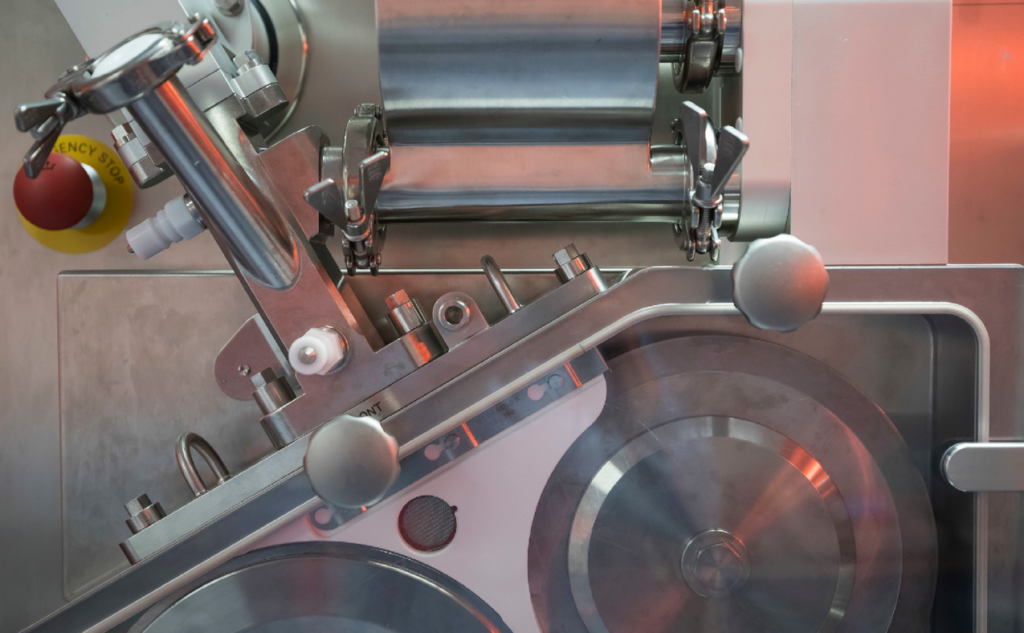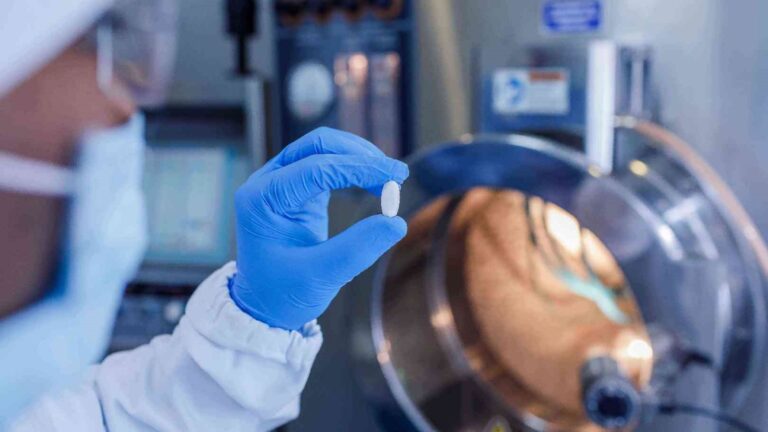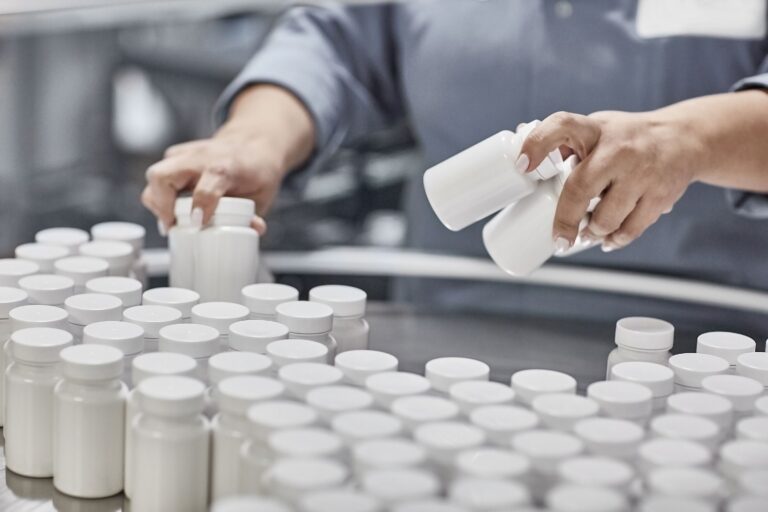
Introduction
Overcoming drug development challenges requires a science-driven approach enhanced by data-driven decision-making and working with the right contract development and manufacturing organization (CDMO) can help achieve optimal results.
For innovators working with oral small molecules, scale-up and technology transfer are critical drug product milestones to successfully reach product launch. Whether moving to manufacturing-scale equipment or transferring a drug product to a new facility when ramping up from research scale to commercial scale, customers expect the drug product will maintain efficacy, quality, and safety. However, a range of technological (both material and drug product manufacturing) challenges can cause projects to be delayed or even cancelled – adding significant costs to the project.
In a recent webinar hosted by Fierce Biotech, two product development experts from Hycon – Uwe Hanenberg, Ph.D., Director of Product Development, and Dejan Lamesic, Ph.D., Product Development Scientific Team Leader – provided strategies for addressing common scale-up and technology transfer challenges. They also discussed the most relevant features when selecting the best qualified CDMO
OVERCOMING COMMON CHALLENGES OF SCALE-UP AND TECHNOLOGY TRANSFER
Firms approaching scale-up and technology transfer often face multiple obstacles:
- Product development is frequently based on a “trial and error” approach and is not always science-driven; therefore, there may be limited knowledge of critical process parameters (CPPs) and / or critical material attributes (CMAs) of drug products. This can lead to insufficient knowledge of the design space with limited or no predictability.
- As production scales, it becomes increasingly difficult to maintain consistent product quality along with managing risk.
- Material properties of active pharmaceutical ingredients (APIs), excipients, and manufacturing process parameters may not be factored in systematically, which can lead to drug product variability during the manufacturing process. This can impact the drug product critical quality attributes (CQAs) and its subsequent quality.
There are four key steps to address these challenges:
1. Embrace Science-Driven Formulation and Manufacturing Process Design
A sound scientific approach to drug development reduces the risks associated with trial-and-error experimentation. Manufacturers should clearly define a quality target product profile and a final drug product control strategy, both of which account for critical parameters and attributes. It is also important to understand equipment and process capabilities and ensure they can accommodate the materials used in drug development. Finally, as discussed below, the use of multiple modeling approaches and modeling tools helps partners make more informed, science-driven decisions.
2. Know Your Materials at All Levels
Knowledge of the APIs, excipients and intermediate(s) material attributes is fundamental to successful manufacturing processes and drug product development. A holistic approach is necessary here,” Lamesic said. Although it is important to understand the impact of materials at three levels – molecular, particle, and bulk – Lamesic noted that material properties at particle and bulk level are usually most critical for the successful scale- up and technical transfer of drug products. For example, particle size distribution and shape may impact flowability, while compaction behavior may impact processability.
3. The Quality by Design Approach
Thorough knowledge of materials and manufacturing processes enables companies to bring a Quality by Design (QbD) approach to drug product development. In this approach, the characteristics of the materials influence the manufacturing process – whether it’s stick pack filling, capsule filling, blending, granulation, extrusion, tableting, coating or another process altogether. These processes in turn influence the finished product’s quality attributes like appearance, assay, stability, dissolution, etc. The key is leveraging a platform that enables a data-driven, informed decision making by incorporating data and digital technology to provide insight into possible outcomes.
4. Develop and Apply Multiple Modeling Approaches
Modeling enhances the value of scale-up and technology transfer by enabling a development process that’s more efficient and takes less time while using fewer, oftentimes scarce materials. It can turn drug product knowledge into wisdom – being able to predict the outcomes in advance. “The goal of modeling is to establish product CQAs as a function of material attributes and process conditions,” Lamesic said. A range of modeling approaches can be used.
Engineering-based models focus on process similarity, models based on process analytical technology (PAT) consider real-time adjustments to process parameters, multivariate data analysis (MVDA) models deal with multivariate impact of input parameters on the drug product properties, physics-based models calculate the motion of materials, and finally hybrid models blend the approaches.
4.1 Leverage Multivariate Data Analysis and Modeling Tools
MVDA, specifically principal component analysis, transforms a large set of variables into a smaller set of variables, which are referred to as the principal components. The variables that make up a principal component can include a range of material or manufacturing process factors such as product temperature, spray rate, porosity and permeability. From there, a score plot can be used to evaluate relationships among various samples, while a loading plot can determine how much an individual variable contributes to a principal component. “Different multivariate tools and mechanistic models accelerate transition from early- to late- stage development and technology transfer by enhancing drug product understanding and predicting of drug product performance,” Lamesic said.
Case Study #1: MVDA Stick Pack Filling Process
A manufacturer wanted to simulate the roller compaction process. Using an established mechanistical roller compaction model, the manufacturer was able to develop, transfer and scale up the roller compaction processes supported by adequate material characterization tools and by in-silico Design of Experiments to evaluate the process design space. This model achieved the simulation’s goal by applying the adequate manufacturing parameters on the first production scale batch to achieve the target solid fraction and achieve consistent desired ribbon density.
Case Study #2: Roller Compaction Process
A manufacturer was producing a multiparticulate drug product using a high shear wet granulation process to produce granules and subsequently filled into stick packs. The manufacturer observed considerable variability in the uniformity of the delivered doses. Through an MVDA, the manufacturer collected and analyzed 36 batches of data and determined the manufacturing process parameters (like spray rate) that critically impacted the stick pack mass variation and drug product content uniformity. This analysis and approach enabled the manufacturer to focus on the right parameters and attributes to ensure that the transfer to an alternative granulator succeeded.

FIVE KEY CONSIDERATIONS WHEN SELECTING A CDMO PARTNER
Selecting a CDMO partner with a shared vision of science-driven formulation and process design, QbD expertise and experience with various modeling approaches are critical factors for successful scale-up and or technology transfer initiatives. Below are five important considerations for identifying the right CDMO partner:
1. All-Around Expertise
A “one-stop shop” will minimize the impact of time pressures and cost controls. Look for a CDMO that is well-positioned to seamlessly transition products from early-stage to late- stage.
Other considerations include extensive project management oversight, a well-defined and transparent project setup, a range of packaging capabilities (e.g., accommodations for products sensitive to temperature and or humidity) and ongoing regulatory compliance in key global markets such as the U.S., EU, Brazil, Japan and South Korea.
Manufacturers benefit greatly from an optimized program for new product introduction. The ideal process will include the following elements:
2. Proven Process for Introducing New Products
- A series of steps, or stage gates, with clearly defined deliverables required to progress from one stage to the next.
- A QbD approach of defining CQA and CPP, specifying design space and control strategy and considering the suitability and implementation of PAT tools.
- An assessment of business risk, safety risk, quality risk and post-launch risk, with assessments revisited and refreshed at each stage gate
- Cross-functional teams that represent major specialties and are accountable for deliverables as well as decision-making
- Standard toolkits, templates and performance management guidelines for project management, including a set of minimum requirements for key processes.
These five main elements together, applied with rigor and discipline, help to accelerate a project, set it up for success and reduce costs as well,” Hanenberg said.
3. Advanced Technologies and Capabilities
Scale-up and technology transfer depend on the ability to manufacture both small and large batches of various product types. A CDMO that can handle a range of manufacturing processes, from roller compaction and high shear granulation to compression, multi- particulate and tablet coating along with hard capsule filling enables the production of many products, including granules, coated pellets, tablets and capsules. Combining these capabilities with advanced modeling technology gives innovators the assurance that their product specifications can be met, the streamlined with minimal risk.
4. Robust Clinical Supply Services
A CDMO that operates as a single legal entity and under a single good manufacturing practice (GMP) license has the ability to move materials between product development and clinical supply departments with more flexibility as shipment and additional incoming goods testing is not required. This reduces delays in the drug development process and clinical supply. In addition, this elevates quality and compliance control along with reducing business complexity (e.g., less contractsare needed) as there are fewer handoffs of supplies throughout the supply chain.
5. Fully Integrated Turnkey Services
When a CDMO oversees drug development from start to finish, an innovator benefits from managing a single relationship with a trusted partner. Fully integrated services reduce uncertainty and risk while providing a more transparent process. Look for a CDMO partner that supports formulation development (including pediatric formulations), clinical supply, multiple manufacturing processes, variety of oral solid dosage forms and product packaging and release. In addition, a CDMO with a global footprint is strategically placed to provide an innovator access to multiple markets.
HOW RENEJIX CAN HELP?
Scale-up and technology transfer of oral small molecules can be a complex process due to the number of variables that can impact product quality, introduce variability and cause delays to the manufacturing process. Drug developers pursuing growth through external scale-up and transfer have numerous choices when searching for a CDMO. The right partner will have not only manufacturing expertise but also proven programs for introducing new products and advanced modeling tools.
At Hycon, proven expertise across technology transfers, special handling, product launches and life cycle management helps innovators bring drug products to market faster, while providing the highest quality products to patients. No matter the state of scale-up or technology transfer that innovators find themselves in, Hycon has the experience and resources to optimize their drug development process.
Learn more about how Hycon’s PharmaPrime™ Solution Accelerates Oral Dosage Products from Clinic to Launch. Hycon is the leading global provider of advanced delivery technologies, development, and manufacturing solutions for oral dosage drugs, consumer health products. With staff having over 30+ years serving the industry, Hycon has proven expertise in bringing more customer products to market faster, enhancing product performance and ensuring reliable global clinical and commercial product supply. For more information, visit www.Hycon.com
Driven by Science, Dedicated to Patients.™
Hycon is a global leader in clinical supply services partnering with pharma and biotech sponsors of all sizes, from the Hycon offers comprehensive clinical supply and integrated development services for sponsors and studies of all sizes. Our capabilities include clinical supply management andforecasting, comparator and reference product sourcing, clinical packaging and labeling, specialty handling and cold chain clinical storage and distribution, direct-to-patient servicesand returns and destruction.
To learn more, visit our website renejix.com







